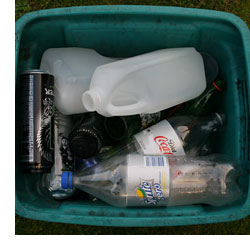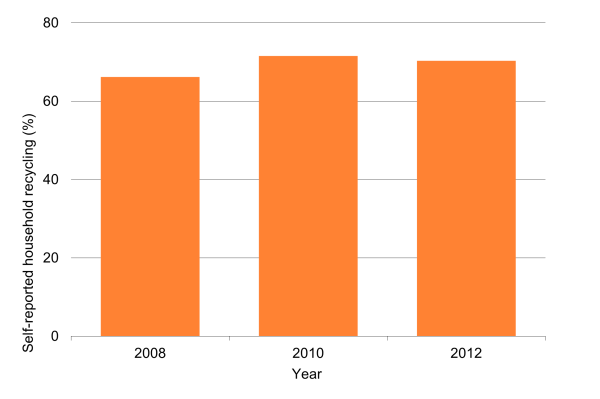Recycling

 RECYCLING
RECYCLING
| IMPROVING TREND |
More people surveyed in the Waikato region are recycling their household waste.
This indicator measures the percentage of people living in the Waikato region who say they are recycling their household waste. It uses survey results drawn from the New Zealand General Social Survey (GSS).
Why is this indicator important?
As industrial activities expand and our population increases, we are using more resources and generating more waste. However, much of our waste could be reused, recycled or composted. Waste disposal is expensive and can cause environmental problems. The less waste we produce, the less we need to dispose of, and the more we use our resources sustainably.
When waste ends up in our landfills, it can indicate how efficiently or inefficiently we are in using our resources. This is particularly concerning when discarding reusable and recyclable materials such as paper, plastic, organic waste, glass and metal. Waste not only pollutes our environment; it can make it unsafe for people to enjoy.
Monitoring what’s being thrown out and what’s being recycled can inform councils’ waste management plans including identifying what extra support people need to make recycling easier for them. It can also help councils in providing the right information and education to people in the Waikato region to increase awareness of the need to use our resources more effectively and how they can make a difference around this.
Percentage of households recycling

| Year | Self-reported household recycling |
| 2008 | 66 |
| 2010 | 72 |
| 2012 | 70 |
What is this indicator telling us?
- This indicator is currently only updated every 10 years and lacks local/regional gathering of data.
- Between 2008 and 2012, the percentage of people surveyed in the Waikato region who said their household recycles ‘all/most of it’ increased from approximately 66% to 70%.
- Despite this improvement, growth in self-reported recycling has lagged behind that of Auckland, Wellington and Christchurch which rate 80-90% on this survey item.
- According to the latest Regional Waste Stocktake, in 2020 there were 33,115 tonnes of kerbside recyclables reported by Waikato territorial authorities.
- According to results from the three-yearly ‘Your Environment – what matters’ survey of Waikato region residents, in 2022 around 40% of the surveyed population listed ‘recycle in general’ as one of their most common personal environmental actions, similar to the 2019 result.
DATA SOURCE AND SUPPORTING INFORMATION
Regional and New Zealand General Social Survey (NZGSS) results are online. Data are obtained from Table 13: Selected NZGSS measures by region.
Rest of North Island results are used as a proxy for Waikato region due to small sample size for this item.
The 2012 GSS results were published by Statistics New Zealand (SNZ) on 13 August 2013. There was no recycling question included in the 2014, 2016, 2018 or 2021 GSS. The GSS is unlikely to include the recycling measure as primary content and therefore its potential frequency of inclusion under the GSS supplement framework would likely be at least 10 yearly intervals.
Tonnage of kerbside recyclables in the Waikato region in 2020 (reported by TAs) is reported on page 62 of the Waikato and Bay of Plenty Regional Waste and Recycling Stocktake 2021 prepared by Sunshine Yates consulting, Eunomia, and Waste Not Consulting.
Data on the perceived quality of waste recycling services and facilities in their area over the past few years are from the Waikato Vital Signs 2020 report, sourced from the 'Your Environment - What matters' three-yearly survey of residents of the Waikato region by Waikato Regional Council.
Update details: Next update may be around 2023/24.
Customised data request requirements: Nil
DATA AVAILABILITY – OTHER THAN WAIKATO REGION:
Territorial Authority (TA) disaggregation: No
Other regions: The survey regions are Auckland, Wellington, Northland/ Bay of Plenty/ Gisborne, Rest of North Island, Canterbury and Rest of South Island. Rest of the North Island is used as proxy for Waikato region due to high sample error associated with Waikato region sub-sample for this item.
New Zealand: Yes
Other countries/ Organisation for Economic Co-operation and Development (OECD): No




To ask for help or report a problem, contact us
Tell us how we can improve the information on this page. (optional)